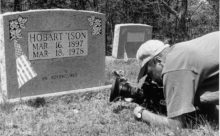Stranger with a Camera, Review by Robert Snyder
Elizabeth Barret uses the tragic death of Hugh O’Connor as a prism for exploring the “complex relationship between social action and social embarrassment.” O’Connor was a promising young director for the National Film Board of Canada. He had earned a respected reputation developing cutting-edge technology (Labyrinthe), making documentaries dealing with humanity in distant settings and exhibiting a personal sensitivity toward his subjects. In 1967 O’Connor went to eastern Kentucky, without much awareness that the people were, as the historians David Whisnant and John Inscoe, J.W. Williamson and others have shown, far more complex, culturally rich, and concerned over image problems than the stories about strikes, disasters, and strip mining abuses had indicated. Hobart Ison was a native of the hills and hollers who had suffered reverses ranging from collapses in the coal economy to being jilted by a lover. He used money received from the railroad for a right of way over family property to build rental units, which had over the years fallen into disrepair. He took his hard work, his hard knocks heritage, and the protection of personal privacy and property rights seriously. Although O’Connor had received permission from some renters to film them, Ison took exception. He shot and killed O’Connor as he was obeying orders to leave the property. While many people outside the region were shocked by this act of violence, local residents rallied behind Ison. After his first trial resulted in a hung jury, Ison pleased guilty to involuntary manslaughter. He was paroled after serving one year of a ten year sentence.
At the time of the incident, Elizabeth Barret was in high school in the next county and in a different world. She had been born and raised in the county seat of Hazzard, knew a good life with food, new clothes, and family vacations, and was a cheerleader and candidate for homecoming queen. Through her church she was introduced to the needy and practiced public service. After college, she took a job at Appalshop in Whitesburg, Kentucky, a place where Appalachians produce their own media, and discovered a world different from the portrayals on TV networks. While President John F. Kennedy’s VISTA (Volunteers in Service to America) volunteers and Lyndon B. Johnson’s War on Poverty had exposed the exploitation of human and physical resources, they had also overlooked the character and creativity of residents and had hurt and embarrassed proud people.
Barret explores the intersection of these lives and complexities through interviews with O’Connor’s colleagues and daughter and Ison’s family, friends, attorney, and a former tenant. She also uses footage from films of the 1960’s, The Crusaders, All’s Right, and Christmas in Appalachia, for background and context. The commentary of Anne Caudill and Harry Caudill of Night Comes to the Cumberlands (1963) fame is balanced against that from members of the Chamber of Commerce. Stranger with a Camera took ten years to make, premiered at Appalshop, has been shown at the Guggenheim, and was screened at Sundance. It is an even handed, incisive, and moving look at many differences and responsibilities documentarians and their subjects face.
